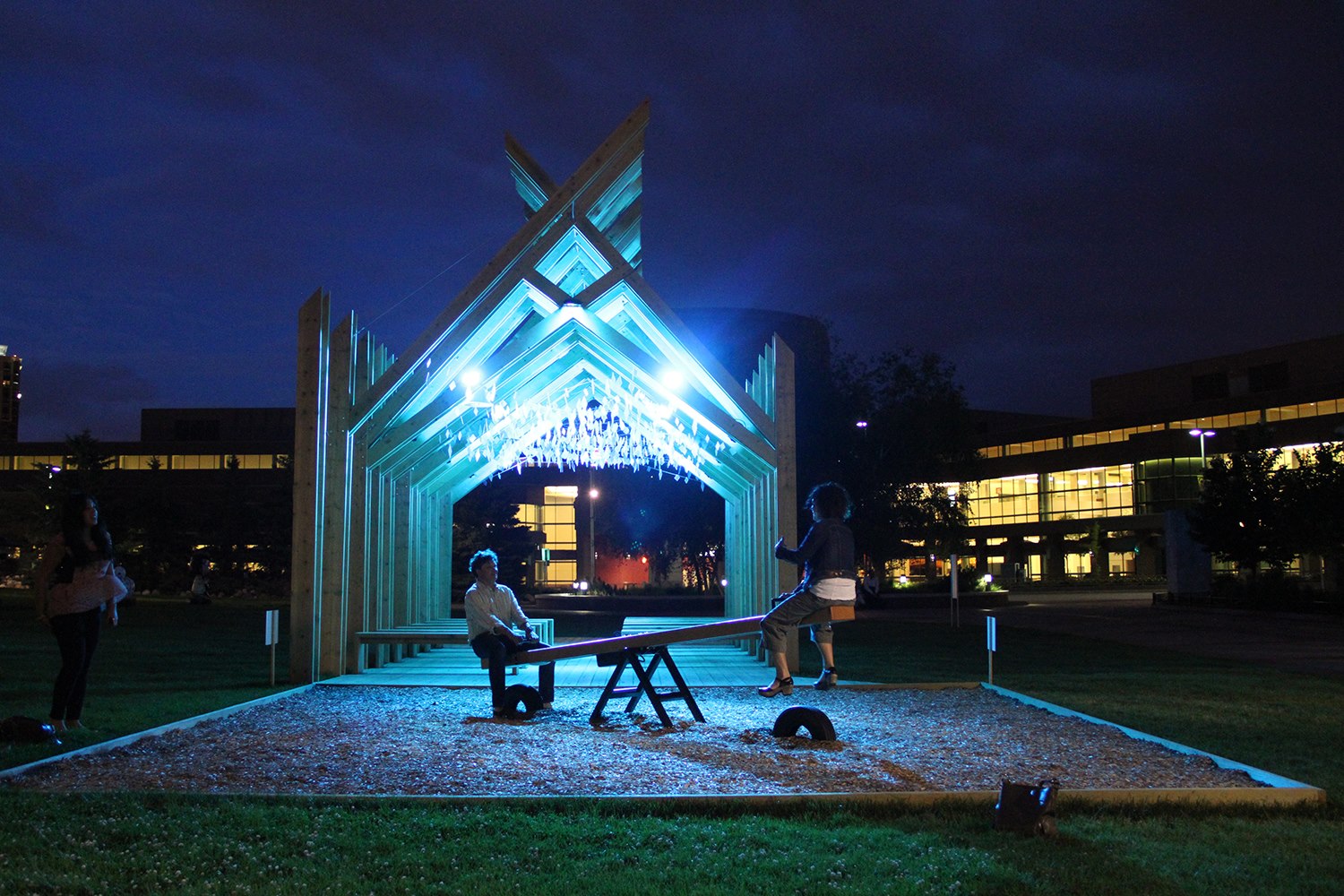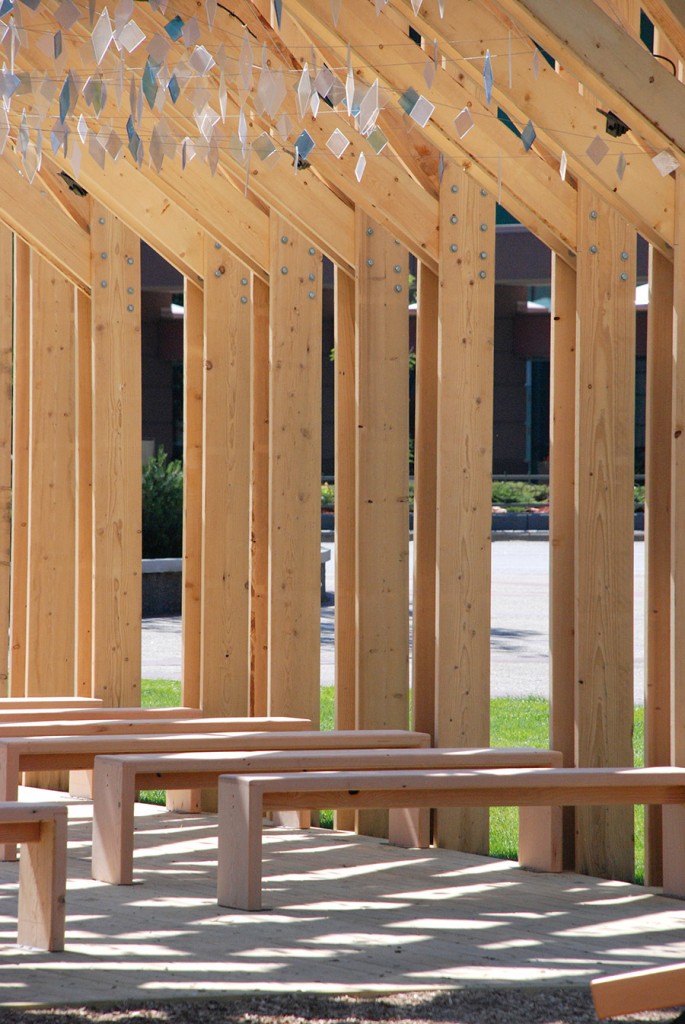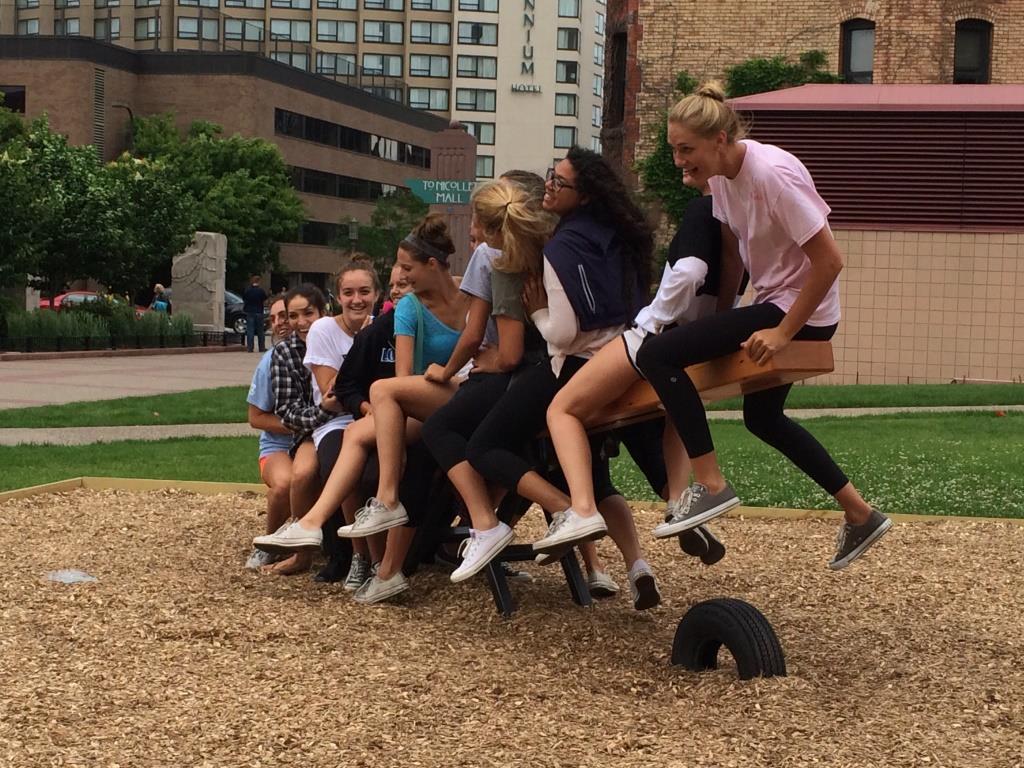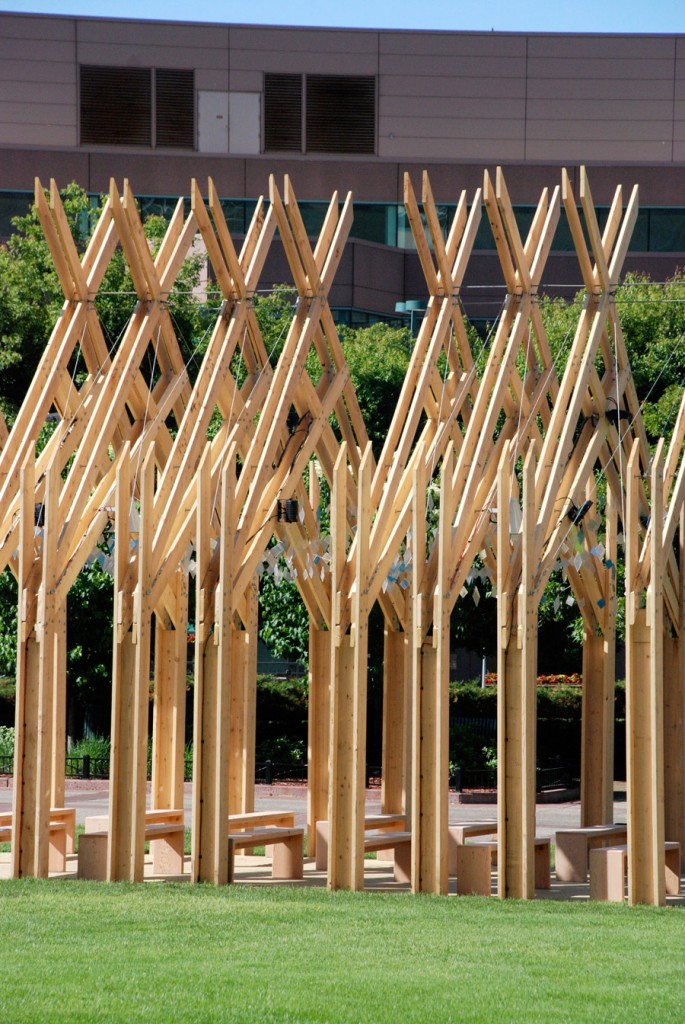A Secular Sanctuary for Play
The Creative City Challenge-winning installation, "Balancing Ground," in downtown Minneapolis takes its cues from barn-raisings, playgrounds, and chapels to create a site for both play and quiet contemplation. Is it trying to do too much?




An interdisciplinary team led by four artists* — Amanda Lovelee, Sarah West, Christopher Field, and Kyle Waites — has erected a skeletal church in downtown Minneapolis, intended as a sanctuary for both play and contemplation. The installation, Balancing Ground, occupies a grassy patch next to the Minneapolis Convention Center. The temporary work earned the annual Creative City Challenge grant, offered this year for the second time. With the help of craftspeople and other collaborators, the artists created a wooden lattice of a building that mimics both a chapel and a barn. Tapered, vertical beams line the edges of a simple plank floor and support a series of double-layered rafters. The beams frame not a roof but the open sky in repeating triangles and trapezoids; lights and reflective glass squares hang from lines mounted in the rafters. The floor is lined with simple, backless wooden benches. And just outside the structure, about where the altar of a church would be, there is a seesaw made of a thick plank of raw wood.
When you enter the structure, or mount the seesaw, it quickly becomes apparent that there’s yet another element to the work — sound. Mounted beneath the seesaw is a nearly invisible speaker system (designed by new media artist, Christopher Field) activated by the movement of the seesaw. Various voices, speaking in a conversational tone, say things about balance as a concept; the recordings vary depending on the speed of your rocking. Inside the structure, longer audio clips likewise activate when you sit on the various benches. These voices provide more context: speakers introduce themselves and then speak about the idea of balance in their lives. On my visit, I listened to the director of an art school talk about work, family, and the rare moments he still finds to pursue his own art practice.
I visited Balancing Ground on a sunny Friday afternoon in June. All of downtown (and especially my hotel) was crawling with high school girl volleyball players and their parents, apparently in town for a tournament of some sort. As I sat on the benches, I watched several groups of volleyball players approach the structure and briefly assess it. As one group approached a girl squealed, “Seesaw!” And then they all piled on, eleven of them, and began to rock as a mom started snapping photos. The recorded voices were barely audible over the din of their giggles.
“It talks!”
“I think it’s calling you fat!”
“I think it’s an art thing, it’s actually pretty cool.”
Then they wandered off. Their entire visit lasted about 90 seconds.
Later, I watched a middle-aged woman precariously surf on the center of the seesaw while her companions rode on either side. Then some parents helped their toddler learn to ride one for the first time, while strangers stopped to photograph the moment. Those who were willing to slow down a bit more explored inside the structure and sat on the benches. I watched an older couple notice the audio recordings and visit several locations where different ones could be heard. They listened quietly to a few, then walked on.
There’s a lot going on with Balancing Ground, and there are many ways to think about it. To attempt to judge its success as an artwork, one first has to figure out what it’s trying to accomplish — and it’s trying to accomplish quite a lot. On the project’s website, the artists state that Balancing Ground “presents a space for playful participation and quiet, reflective moments.” It succeeds in both these efforts, but even in its success it may be trying to do too much. Both the structure and this statement by the artist raise the questions: Can a space truly exist for both playful participation and reflective moments? And should it?
I spoke to Lovelee, project lead for public engagement, about the work. We talked about barn raisings, church, and community. Many artists and thinkers have explored the notion of art taking on greater spiritual and ritualistic dimensions as a response to the fact that religion is no longer central to public life, and Lovelee, too, framed Balancing Ground in this way. She said she wondered where people gather when they no longer go to church. For her, creating a secular chapel wasn’t an exploration or critique of religion; it was a way to reclaim in shared civic space and mode of gathering.
Balancing Ground succeeds in being self-evidently open and welcoming. People do not need to be coaxed into entering the structure. They don’t need to be told how it works or what it means in order to gain something from the experiences on offer. The installation (whose sculptural elements and lighting design are the work of Sarah West and Kyle Waites respectively) accomplishes all this with its position, with the embedded architectural references to familiar structures and methods of interaction that play well to pedestrian traffic. When people are walking around downtown, sitting on a bench or playing on a seesaw is, on its face, a welcome idea.
______________________________________________________
In its simplest sense, the structure is a chapel with a piece of playground equipment in place of an altar, a church dedicated to the reflection and appreciation of play.
______________________________________________________
But there are ways in which the work stumbles. At first glance, the structure doesn’t seem to have content, per se, just an assemblage of architectural cues and variously playful and contemplative opportunities to interact. Specific notes on the work come from the audio recordings; and the audio, like the title of the work, makes it plain that the project is about balance — balance in life, physical balance, balance, balance, balance.
As I sat on a bench watching the seesaw in action, I found myself questioning whether the work actually needs this express content about balance at all. In its simplest sense, the structure is a chapel with a piece of playground equipment in place of an altar, a church dedicated to the reflection and appreciation of play. Balance, or the lack thereof, is how a seesaw functions, but that’s only one, very small element worthy of note in the activity. What about gravity? What about the curious physics of a lever? What about that sense of anticipation followed by the pain you feel when your end of the seesaw strikes the ground a little too hard? All of these things are present, too, but they’re harder to access because of the constant presence of audio narratives nudging your mind back to the idea of balance.
The sound recordings remind me of the didactic audio messages that sometimes accompany diorama displays in museums of natural history or science. A lot of this tech has been updated, but it used to be that you’d approach one of these displays and there’d be a big, friendly button. When pressed, a short audio message would inform you about the scene in front of you, freeing you from needing to read a didactic wall text. The recordings about balance that play when you sit on various benches function similarly. But such didactics seem antithetical to the aim of creating a non-denominational space for quiet contemplation and convivial play. What’s more, the preset audio clips effectively function as timers. The recorded voice stops speaking, and the implied message is that you are done: you’ve received the knowledge contained in this space, and it’s time to move on. In this way, the audio recordings in Balancing Ground actually work against what the project is otherwise poised to do well. The structure itself succeeds as a place to linger, rest, play, chat, and take notice of the people and the city around you. Balance is indeed a powerful idea undergirding the work, but there’s so much more going on here that might bubble up in the lived experience of its offerings given more open-ended space to do so.
I left Minneapolis and continued to reflect on Balancing Ground, particularly the artist’s notion of fostering congregation and a sense of the sacred in the absence of specific concern with religion. It strikes me that religion has additional, less holy but still significant, ways of animating and giving meaning to the buildings we call churches. Churches are sites of ritual and rhythm. They’re places of gathering, yes, but it’s gathering with purpose — gathering that happens on a cycle, for a particular reason and with a particular group of people. A church is not a building; a church is a group of people joined in belief and common cause. Balancing Ground offers the scaffolding, but not the substance of such fellowship. Which leads to a larger question: Is this work truly a meeting place, or is it a structure that points to the idea of a meeting place? Is it really a church without religion, or just an object lesson, a sketch illustrating what a church without religion could be?
Regardless, the installation manages to be both an object of contemplation and a real, useful thing. Put another way, it’s both an artwork and a piece of architecture. Balancing Ground might not quite meet its lofty aspirations, but it still manages to deepen and enrich its little corner of the city.
*CORRECTION: The original version of this essay listed only Amanda Lovelee as the artist responsible for Balancing Ground. The installation is instead the result of a collaboration by several artists, and the text has been changed to reflect the contributions of each. (Return to top)
______________________________________________________
Related information:
Balancing Ground has been installed in the Minneapolis Convention Center Plaza (1301 Second Avenue South, Minneapolis) since June and will remain on view through the end of September, 2014. For more, visit the website at www.balancingground.com.
Balancing Ground at Northern Spark from Northern Spark on Vimeo.
Kevin Buist is an artist, writer, curator, and critic of art and film. He has exhibited artwork in solo and group exhibitions in New York City and Grand Rapids, and has been featured in numerous print and online publications including the ART:21 blog, where he was a blogger-in-residence, as well as mnartists.org, Solace Magazine, and kevinbuist.com/blog.